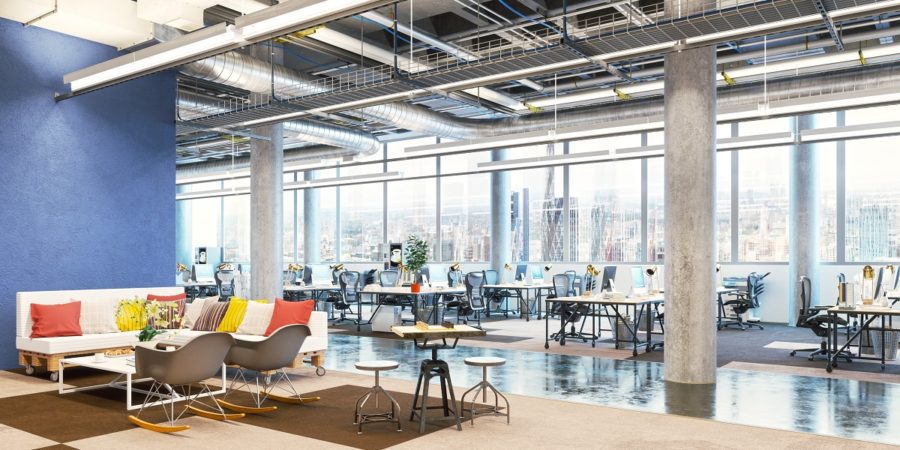
Commercial
Flexible Office Spaces: What Are the Benefits?
Written by: Parcel Pending
4 Min Read
Published: August 22, 2022
Updated: April 13, 2024
Updated 04/13/2024
While the traditional office space may appeal to employers with permanent and assigned locations for employee desks, flexible office spaces allow employees to select the areas of the office that best suit their needs. A flexible office space can also be easily reorganized to adapt to different teams or an organization’s changing business goals. In essence, flexible workspaces and flexible office spaces aim to provide employees with various places and ways to work.
Are you trying to determine if a flexible office space or flexible workspace solutions are the right fit for your business? Read on to find out more about the benefits of flexible working as well as get tips for how to implement more flexibility in your office.
What is flexible working?
Flexible working or activity based working, alternatives to traditional, mandatory in-office working, allow employers to offer employees various options for how and where they want to work. For example, flexible working could mean working in different locations around the office, working staggered hours or part-time, or working from home.
Flexible working promotes a healthy work-life balance as employees can set their own schedules to accommodate other obligations, such as doctors’ appointments and caring for family members (like children).
What are the benefits of flexible working?
A flexible office space boosts employee productivity because it offers teams access to the resources and shared spaces necessary to get their work done well. Workers find it easier to meet goals when their companies provide a comfortable and appealing office layout that encourages creativity and responds to their changing needs.
In addition, a flexible office space can help companies cut their overhead costs. Since many workers opt to work remotely or spend just part of the week in the office, organizations don’t need to provide as much individualized space for their employees.
Since the COVID-19 pandemic, many companies that insist employees work in-office have struggled to persuade talented workers to join their firms. On the other hand, companies that offer employees the flexibility to work from home at least several days a week have been more successful at hiring and retaining top-notch employees.
Ways to create open floor space
One of the reasons for establishing a flexible space in your office is to create an open coworking space that allows many employees to work in the same room, while still providing private office areas to give employees quiet spaces when necessary.
The following are ways companies can create flexible office spaces and coworking spaces:
- Open floor plans for collaborative working: An open floor plan, where there are no internal walls and no private office environments, is a fundamental feature of the flexible workspace, as it encourages communication and collaboration between employees in various business units.
- Quiet areas: A negative side effect of flexible workspaces and open-plan offices is the rise in ambient noise. Consequently, companies should designate quiet areas (such as private office spaces) to give employees a place where they can focus on their work without being interrupted. This flexible office solution includes allocating a quiet corner of a room or a closed-door office where employees can retreat when they want to complete a project or make a phone call, for example.
- Adaptable workstations: Comfort is crucial when it comes to hot-desking, i.e., earmarking desks to workers on a rotating schedule or when the need arises rather than assigning a specific desk to a specific worker indefinitely. A flexible workspace often includes alternative styles of workstations and hot desking equipment, such as height-adjustable standing desks in common areas that encourage workers to move around. Companies could also incorporate relaxed corners using comfortable chairs and natural lighting to create flexible, inviting spaces in their hybrid office design where people will want to work.
- Docking stations: Universal docking stations are also important when it comes to a flex office space and shared desk space since they allow workers to plug in their devices at any workstation regardless of their devices’ hardware or brand.
Other tools to help create a flexible office space
In addition to adaptable workstations, divider walls and furniture – such as foldable tables that fit together for conference meetings – enable companies to make the most of their space. This flexible furniture and office layout can help companies save money since they can reuse most of the equipment as their organizations grow and their office dynamics and cultures change.
Traditional employees who are assigned to specific desks usually store their personal and work materials at their desks. But companies that implement flexible workspaces can centralize these materials, such as pens, notebooks, and even snacks, making them more available to every worker in a coworking space compared to a traditional office set-up.
To make life in a flexible shared workspace convenient for employees, companies should consider installing smart electronic locker systems that can adapt to the changing business environment. Without permanently assigned desks or cubicles in flexible office space, companies need to have a way to transfer documents, badges, laptops, and other physical resources safely and securely between departments.
Organizations using flexible spaces in their office or coworking spaces can use smart commercial lockers for package deliveries, as well. Employees receive instant delivery notifications and can retrieve packages and company assets contact-free at their convenience from the smart lockers. And a smart parcel locker system allows facility managers to easily keep track of which lockers are being used and when to maximize delivery efficiency.
A flex office space offers many benefits to an organization and its workers. It boosts employee productivity, improves job satisfaction, and enhances work-life balance, all of which improve the company’s performance.
To learn more about how our office locker solutions can help you provide a more flexible workspace for your employees, fill out the form below.



